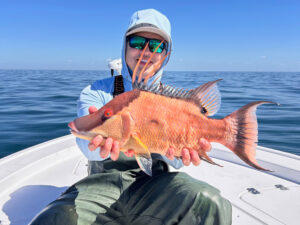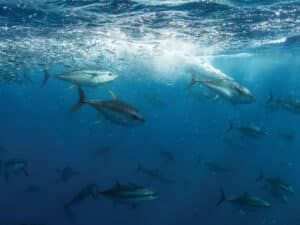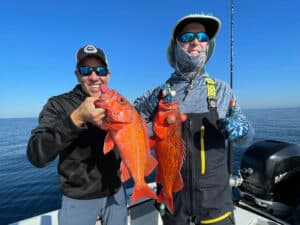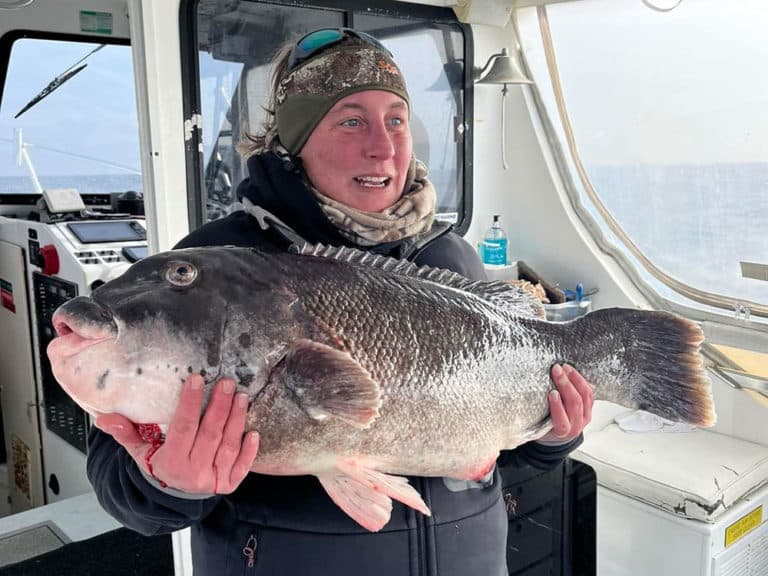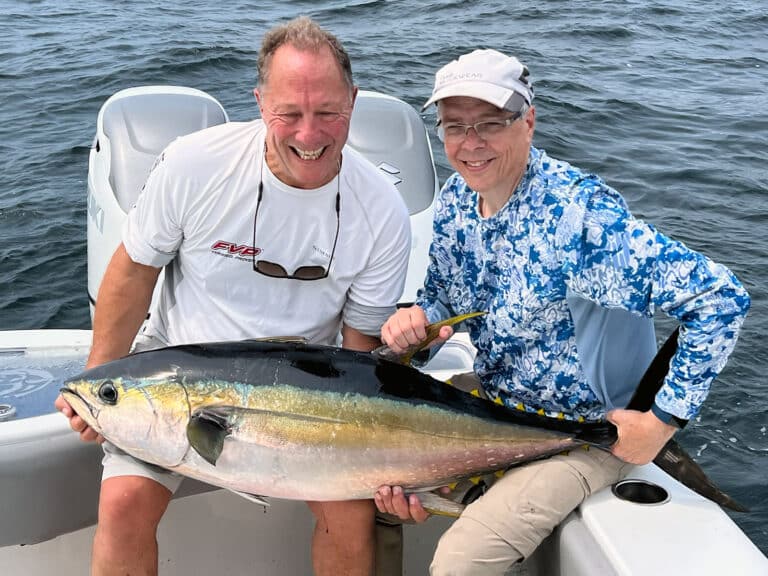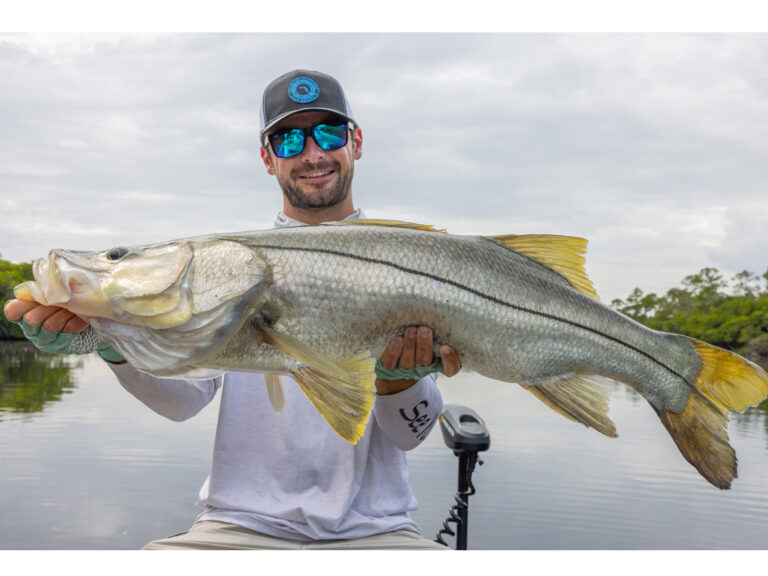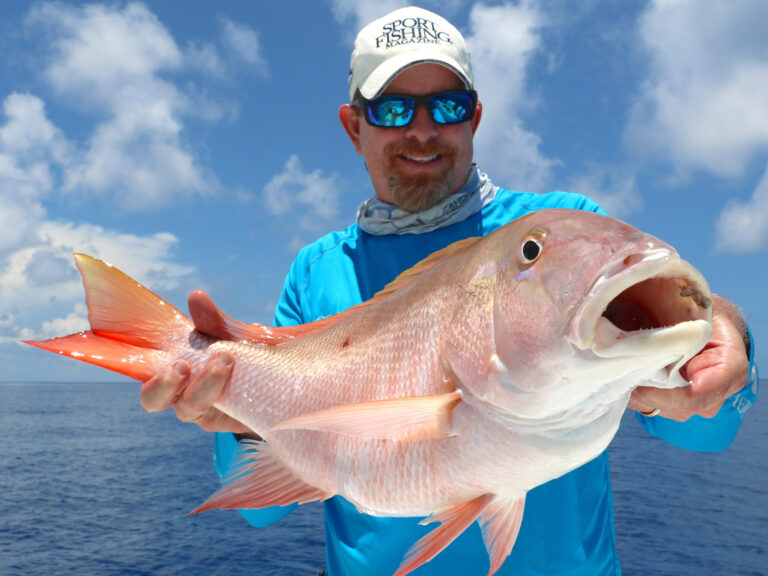Odds Are Good on a Black Jack
QUESTION:
I caught this fish 120 miles offshore out of Freeport, Texas, while chunking for tuna at Hoover Spar. No one aboard had seen one before. What in the world did I come across?
Mikkel Simoes-Correia
Spring, Texas

ANSWER:
Mikkel, you caught a real prize: That’s a black jack, Caranx lugubris. And it is for sure a rarity in the northern Gulf. But the species is exceptionally widespread, found in all of our planet’s major tropical oceans, especially around oceanic islands. Since it favors offshore waters, usually in depths of more than several hundred feet, not a whole lot is known about the species. Although I’ve not seen one more than 20 pounds, they do get larger: The IGFA all-tackle world record weighed 41 pounds, 7 ounces, caught in the Pacific at Mexico’s Hurricane Bank in 2013. It is an important food species in some developing nations’ markets, and some people consider it excellent, but it is a bloody beast, similar to our crevalle jack. Also, it has been implicated in ciguatera poisoning. So I think the best advice for anyone catching a black jack is to take a photo and toss it back.
—Bob Shipp
Painful Discovery
QUESTION:
Our skipper out of Port Canaveral, Florida, hauled in his cast net early on a winter morning, along with a passel of pogies and—most unfortunately—a man-of-war jellyfish. Along with some surprise stings from tentacles stuck in the net, we saw this little feller drop out onto the deck. Its unusual color pattern caught our eye, but no one knew for sure what it might be.
Scott Salyers
Miami
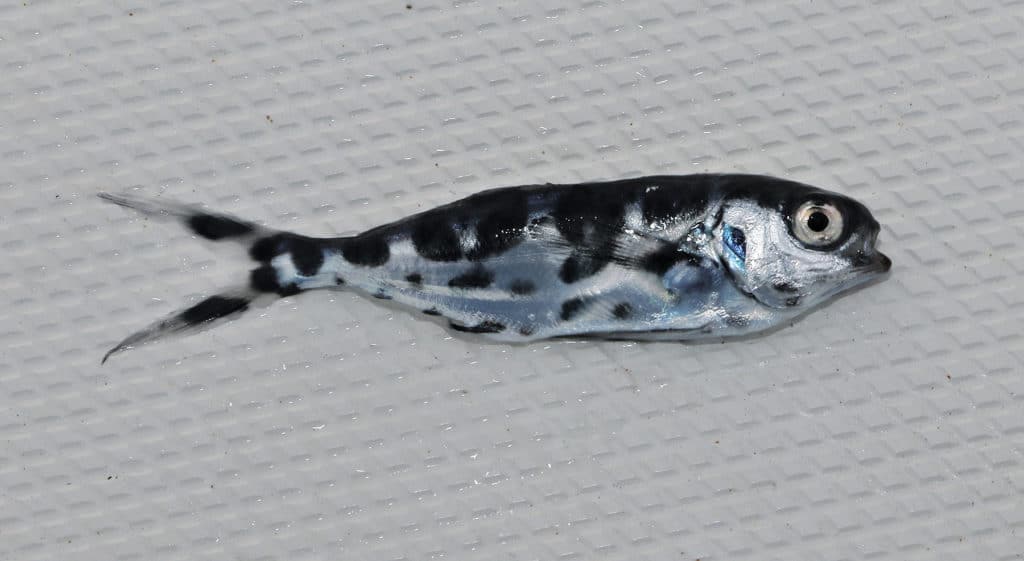
ANSWER:
That’s an interesting little fish, Scott: a juvenile man-of-war fish, Nomeus gronovii. As its name implies, juveniles live in a symbiotic relationship with Portuguese man-of-war, Physalia physalis. Although it somewhat resembles a jellyfish, the Portuguese man-of-war is actually a colonial hydrozoan that is more closely related to fire corals, Millepora spp. (which are not true corals) than it is to the jellyfishes. The relationship between the fish and its host appears to be mutual: The Portuguese man-of-war likely benefits from the man-of-war fish luring other fishes into its waiting tentacles, and the fish benefits by receiving protection from, and feeding on portions of, its hydrozoan host. The man-of-war fish is not immune to nor able to suppress the stings of the Portuguese man-of-war; rather, it is highly maneuverable and skillfully avoids the hydrozoan’s potentially lethal tentacles. Adult man-of-war fish may reach nearly 16 inches in length and, unlike their young, live in offshore waters to depths in excess of 3,000 feet. The man-of-war fish is widely distributed in the tropical, subtropical, and warm temperate Atlantic, Pacific and Indian oceans, although it hasn’t been reported from the Mediterranean Sea and is rare in portions of the eastern Atlantic. Due to its small size and the deep habitat frequented by adults, it has no commercial value. I have never tried eating one myself, and I’ve never read a report dealing with its food value.
—Ray Waldner
Saddle Up
QUESTION:
I caught this while jigging off Madagascar. It looks like some sort of goatfish? Can you identify it and tell me more about it?
Julien Lajournade
Fishing & Travel
Paris

ANSWER:
What you have there, Julien, is a very nice gold-saddle goatfish (Parupeneus cyclostomus) in a rare red color phase. This species can display any of several color variations, most commonly a purplish-gray body with blue edges to the scales. But it can also be entirely yellow. This one, however, is the rarer reddish-pink phase that has provided this species the alternative name of red mullet. You can still see the very faint yellow color of the “saddle” covering the upper side of the caudal peduncle (tail wrist), and if you look very closely, you can see several short narrow blue bands radiating from the eye, a marking that is particular to this species among goatfishes.
The gold-saddle is one of the largest of goatfishes, growing to 20 inches long and around 5 pounds. It occurs primarily over sand and rubble areas on coral reefs and inshore waters in much of the Indo-Pacific region. Stomach-content analyses suggest the species eats mainly fish, which is a little unusual for goatfishes (but not unique), and is probably why it took a liking to your large jig.
—Ben Diggles
Hold Your Tonguefish
QUESTION:
This past August, while netting bait shrimp in a shallow creek in Murrells Inlet, South Carolina, I found two of these little guys in the bottom of my bucket. I’ve caught some uncommon flatfish in the past, such as windowpane flounder and hogchokers, but none as narrow or tapered as these little guys. What do the experts say?
RJ Green
Socastee, South Carolina

ANSWER:
You caught two tonguefish, members of the family Cynoglossidae, RJ. While I can’t be certain of the species from looking at your photographs, I believe your catches were freckled tonguefish, Symphurus nebulosus. This isn’t exactly a large species; it reaches a known maximum length of only just over 3 inches. Its range extends from New York through much of South Florida’s Atlantic coastline. The freckled tonguefish is known to inhabit muddy-bottom areas of the lower continental shelf and upper continental slope, which makes your shallow-water catch highly unusual—if, in fact, is it S. nebulosus. Little is known of the freckled tonguefish’s biology; being small, lacking any commercial value, and living in relatively deep water, it is rarely encountered by anglers.
—Ray Waldner
Little Guy with a Big Eye
QUESTION:
I hooked this fish while jigging at night in 600 feet of water around South Luconia Shoal, off Borneo, southwest of the Spratly Islands. What is it?
Anthony Loo
Via email
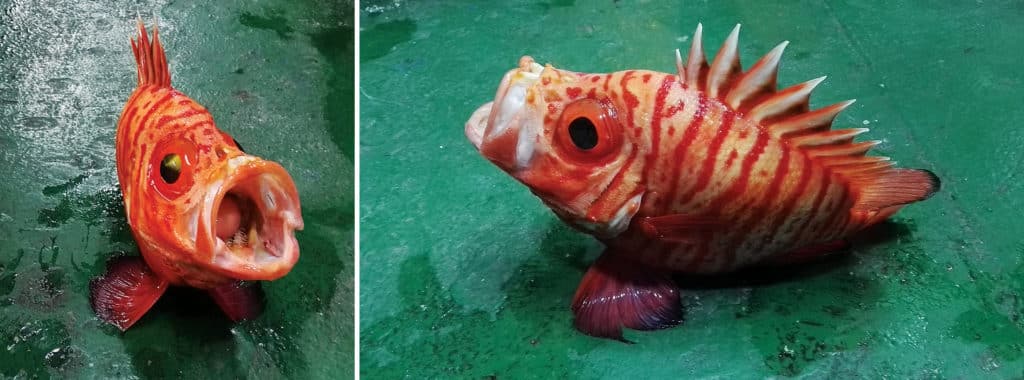
ANSWER:
That, Anthony, is a Meyers bigeye, also known as a striped bigeye (Pristigenys meyeri). These pretty little deepwater fish are members of the family Priacanthidae (bigeyes), found in the South China Sea south to northern Australia. Bigeyes are nocturnal, remaining inside caves and under crevices during the day in waters up to 1,000 feet deep or more. Juvenile fish, however, can stray into shallower waters, where they are sometimes collected alive since they’re considered a high-value aquarium fish. Not much is known about the biology of P. meyeri, but it grows to around 9 inches long and, like other species of bigeye, probably feeds on shrimps, other crustaceans and smaller fishes.
—Ben Diggles
Read Next: Strange Fishes From the Deep: Chimaeras and More
Sport Fishing‘s Prestigious International Panel of Experts
Northeast
Mike Fahay, Sandy Hook Marine Lab, New Jersey
Southeast
Ray Waldner, Ph.D., Palm Beach Atlantic University, Florida
Gulf of Mexico
Bob Shipp, Ph.D., University of South Alabama
West Coast
Milton Love, Ph.D., UCSB, California
Far Pacific
Ben Diggles, Ph.D., Queensland, Australia
Bluewater Pelagics
John Graves, Ph.D., Virginia Institute of Marine Science

CHALLENGE OUR EXPERTS (And Win Up to 10,800 Yards of Line!)
Send in your question and any relevant photos of your mysterious catch or observation for our experts’ ID and feedback. If we publish your question and you have a shipping address within the United States or Canada, you’ll win a 3‑pound spool of Berkley Pro Spec ocean-blue or fluorescent-yellow monofilament (1,000 to 10,800 yards, depending on line strength) or a 1,500‑yard spool of Spiderwire Stealth braid up to 100‑pound‑test! Send questions and images via email to fishfacts@sportfishing.com (include your hometown) or via post to Sport Fishing Fish Facts, 460 N. Orlando Ave., Suite 200, Winter Park, FL 32789.

Fish Facts Expert’s New Guide Now Available
Sport Fishing‘s Fish Facts expert on pelagic species, John Graves, has co-authored—with Bruce Collette—a new and definitive resource, Tunas and Billfishes of the World. With impressively detailed, precise color illustrations by Val Kells, the 352-page volume describes 61 species of mackerels, tunas, swordfish, sailfishes and marlins. The book is certain to become an essential addition to the library of any angler who is serious about bluewater gamefish. Visit tunasandbillfishes.com for more information or to order a copy.

